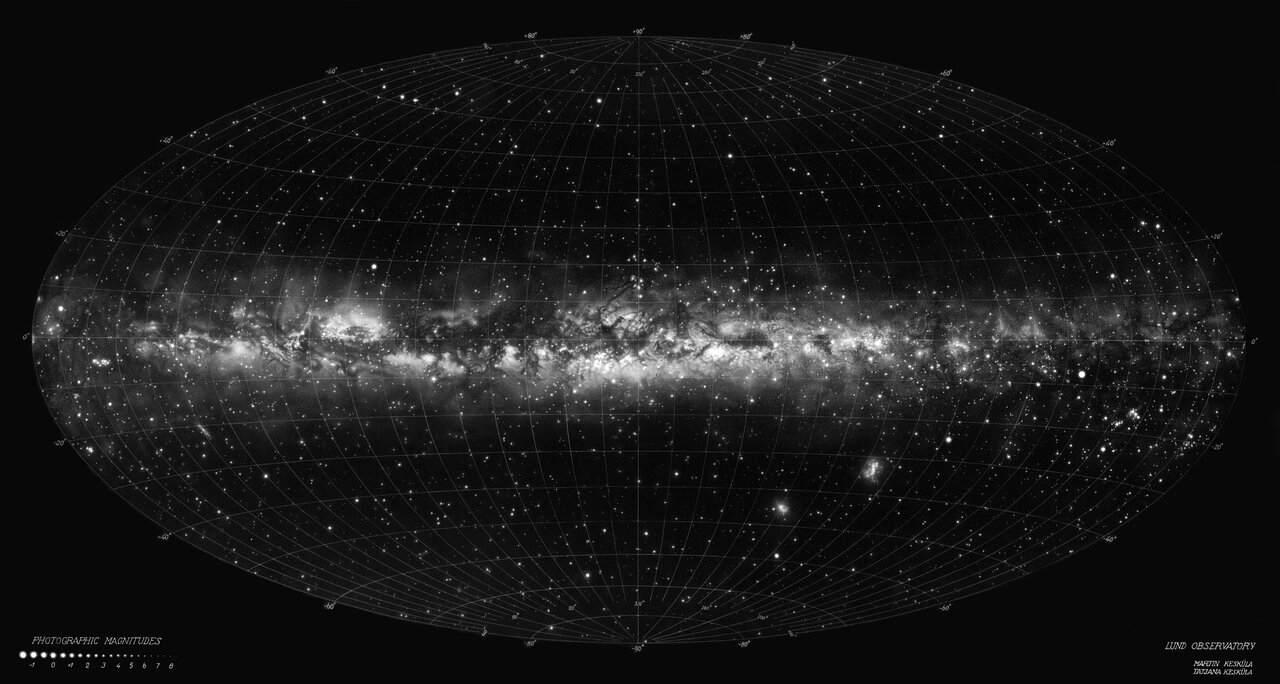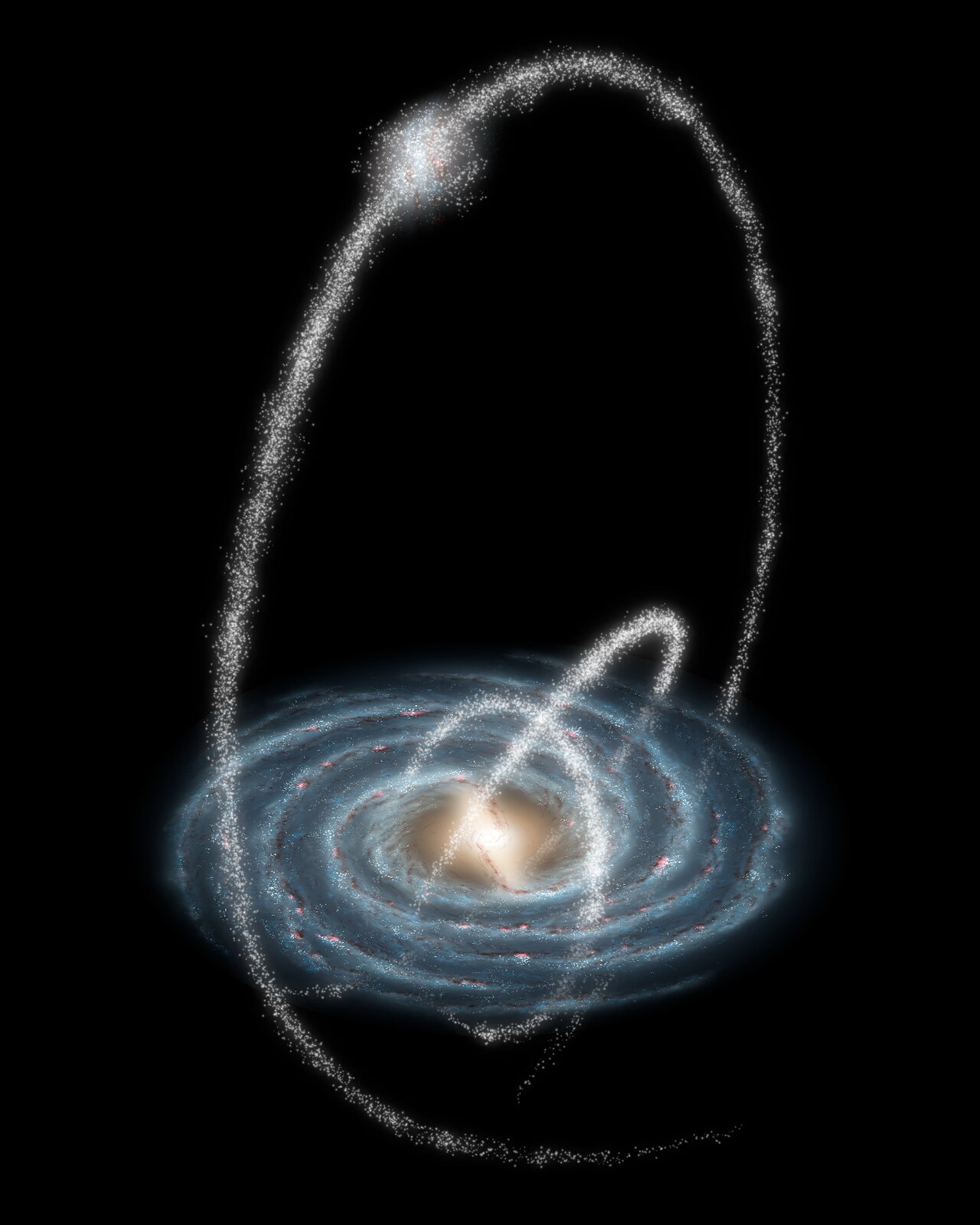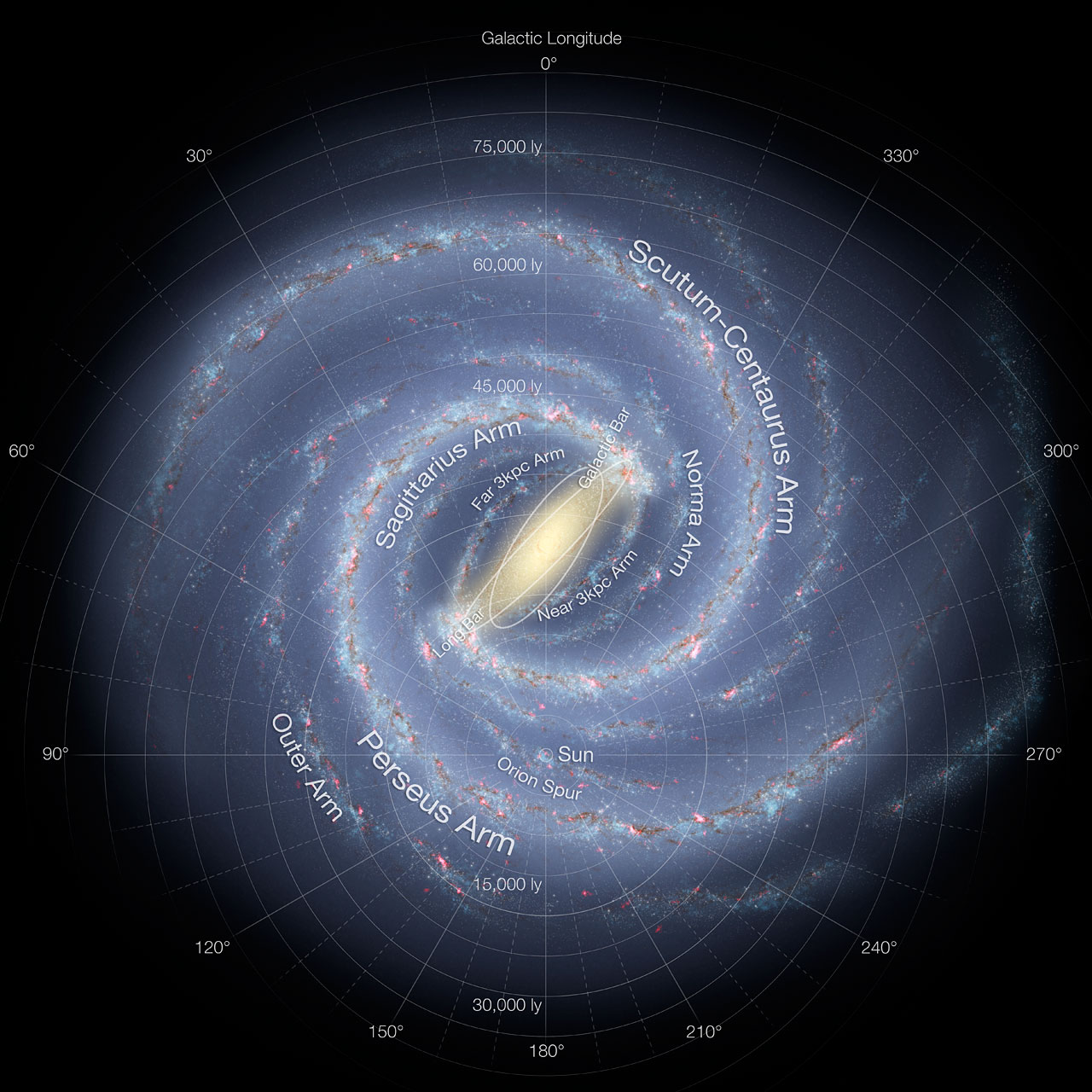- How astronomers study the Milky Way
- The synergy between ESO telescopes on the ground and the Gaia telescope in space
- The violent past, present and future of our home galaxy
We have imaged millions of galaxies, but we have so far not been able to take an image of our home galaxy as seen from the outside. So, how do we know what it actually looks like? And how it came to be and has evolved? With the combined power of ground- and space-based telescopes, astronomers can map and do archaeological studies of the Milky Way, to unveil its dramatic past, and peer into its future.
How do we study the galaxy where we live? It’s a bit like being asked to draw a map of the city you live in, without being able to leave your house. You might be able to peer through the windows and see some features like streets and tall buildings, but most will be hidden by nearby houses. It is quite similar when trying to image the Milky Way. Voyager 1, the most distant human-made object, has been travelling for 45 years and is now more than 20 billion kilometres away. Still, that’s pretty much next door in galactic terms: you would need to be several million times further away to get a clear view of the Milky Way from the outside.
We sit within the Milky Way, and as we look up in the sky we see the hazy stellar band of our galaxy, and clouds of dust obscuring the inner parts of the galaxy, making galactic mapping even harder. Follow along as we draw the map of the Milky Way, starting from the first draft.
A walk down memory lane…
One of the first ever attempts to make a map of the Milky Way was in 1785 by the astronomers, and siblings, Caroline and William Herschel. The Herschels counted the stars they could see in the night sky, and they assumed the galaxy was deeper in the directions where there were more stars. The regions shielded by dust and gas towards the constellation of Sagittarius are already evident in this map, in the white space between the two reaching arms on the right. We now know that this region is the centre of the Milky Way, but back then it was supposed to be one of the edges, as stars to the other side were blocked from our view.

We have only known for about 100 years that galaxies outside of the Milky Way exist, but this discovery was not without controversy. In the early 1900, Harlow Shapley measured the distribution of globular clusters – old, massive collections of stars – in the Milky Way. He found them to be in a spherical arrangement around, what he correctly assumed, is the centre of the galaxy. This allowed him to both estimate the actual size of the Milky Way, as well as to place the Sun within it (and it was not in the centre!).
At the same time, Heber Curtis was measuring the optical spectrum of the, at the time, spiral-shaped “Andromeda nebula”, arguing for its resemblance to the Milky Way, leading to his conclusion that there existed galaxies outside of our own. This led to a hefty discussion among astronomers, regarding the status of Andromeda as a galaxy of its own or as a nebulous cloud within the Milky Way. This discussion in 1920 was so pivotal that it has been given the name “The Great Debate”. Even though Shapley argued that nothing could be as large as the Milky Way, the debate was settled in Curtis favour when Edwin Hubble managed to measure the distance to the stars in Andromeda, and concluded them to be 10 times further away than the most distant stars in the Milky Way. This marked the beginning of a new era in astronomical research, recognising that the observable size of the Universe was much bigger than previously envisioned.
The leap in mapping the Milky Way came in the early 1990s when Lennart Lindegren, together with Michael Perryman and the European Space Agency (ESA), proposed the Gaia space telescope mission, the successor to the Hipparcos mission (1989-1993). Launched in 2013, the Gaia telescope has provided invaluable information about the appearance of our galaxy.

How do we map the galaxy?
Gaia is an expert at measuring the position and velocities of the stars, with so far having mapped almost 2 billion stars in the Milky Way, which is still only 1% of all stars in the galaxy. This allows astronomers to trace the structures of the Milky Way. They can also model the motions of the stars into the past as well as into the future, giving clues as to what the galaxy used to look like, and what’s up ahead.

But how can Gaia measure the distance to a star? It does so by observing how the star moves with respect to background stars, using stellar parallax. You can try this yourself by sticking out your finger in front of you, and now close one eye, and then switch. Notice how your finger seems to move with respect to the background. If you move your finger further away, it will appear to move less, or the angle is smaller. For the stars, we can use the same principle, but instead of having our two eyes, we now use Earth’s orbit around the Sun as our two viewing points. Using the angle of the apparent shift and the distance between the Sun and Earth, the distance to the star can be measured.
Galactic archaeologists study the history of our galaxy and the stars in the sky are their fossils, which provide clues to the Milky Way’s past. To do so, astronomers need to measure the chemical fingerprint of stars, which tells astronomers what they are made of, and in turn what the gas cloud they formed from consisted of, giving clues to their age and origin. However, stars tend to move away from their birthplace, making the puzzle much harder to solve. The chemical fingerprint is obtained through spectroscopy, which just so happens to be one of the many areas of expertise of ESO’s telescopes and instruments. Gaia on the other hand excels at tracking stellar positions and motions, which makes the synergy between Gaia and ESO uniquely suited to unravel how our galaxy formed.
The synergy of ESO and Gaia spans many fields. First, ESO keeps track of the Gaia telescope, making sure that it stays where it’s supposed to be in space. Secondly, the Gaia-ESO public survey uses ESO’s facilities to obtain the chemical information of stars tracked by Gaia, with the goal of further unravelling the mystery of the Milky Way.
The Gaia-ESO survey uses the Fibre Large Array Multi Element Spectrograph (FLAMES) on ESO’s Very Large Telescope (VLT) based in ESO’s Paranal site in the Chilean desert. This instrument allows astronomers to gather spectra for more than 100 stars simultaneously, thanks to optical fibres that are carefully arranged by a robot at the locations of the target stars. Over the course of 6 years the Gaia-ESO survey collected spectra for over 100 000 stars. The science output from this survey is immense; at the time of writing close to 200 studies have been published using Gaia-ESO data. A more thorough background on Gaia-ESO can be found in this previous blog post, but for now, let’s go deeper into the Milky Way and see what we can learn about its history with the help of Gaia-ESO.
|
|
|
Building the Milky Way
In simplified terms, to build a galaxy, we first need gas and dark matter. Thanks to gravity, the gas will collapse into stars, which are gravitationally bound and swirl together creating a galaxy. Over time, the galaxy will change and evolve, partly due to the evolution of the stars themselves. During their lifetime, stars fuse hydrogen and helium into heavier elements that are then expelled into the surrounding gas. Subsequent generations of stars that form out of that enriched gas will incorporate those heavy elements into their composition. By studying the chemical fingerprints of the stars, we can then distinguish their different generations.
The Milky Way is a spiral galaxy, with a disc that has well-defined spiral arms and a puffed up region in the middle called the bulge. The disc and bulge are embedded in a halo that contains globular stellar clusters and dark matter. However, this is a very broad and simplified description of our home galaxy. Did you know that the Milky Way disc actually consists of two discs? These were discovered in the early 80’s when astronomers started counting the stars in the Milky Way, finding two discs camouflaging as one, with different thickness and densities, giving them the names the “thick” and the “thin” disc. They kind of look like a sandwich, with the thin disc in the middle. Over time, thanks in part to the Gaia-ESO survey, it has been found that the discs can be separated both in age and in chemistry. The thick disc has been shown to be 9 billion years older than its thin counterpart and also has less heavy elements. Also, the thin disc is rich in gas and dust, whereas the thick disc contains mostly stars.
A violent past, present and future – hold on tight!

Now, where do these two discs come from? Astronomers believe that they’re the result of the Milky Way having engulfed old galaxies in the past.
Sometimes galaxies pass right through each other, producing ring-like structures, or tearing each other apart whilst merging into larger systems. The Milky Way hasn’t undergone such major interaction with a similarly large galaxy, but it has gobbled smaller ones, whose remnants can be observed in the discs and halo of the Milky Way.
By studying the motion and chemical makeup of stars in the Milky Way, astronomers found the scattered remains of an old engulfed galaxy that had been torn to pieces several billion years ago, and whose stars are now part of the thick disc of the Milky Way. But the thick disc is not the only graveyard of past accreted galaxies: in the halo of the Milky Way astronomers have also found remnants of several digested galaxies. All these infalling galaxies have thus participated in the evolution and shaping of our home.
However, that’s not the end of the Milky Way's hectic history. Actually, our galaxy is in the process of engulfing another galaxy right now: the dwarf galaxy Sagittarius. The Sagittarius galaxy has been passing through into our galaxy several times, being torn apart by the gravity of the Milky Way more and more for every passing. Just like throwing a rock in water, the repeated plunges of Sagittarius into the Milky Way have created ripples in the overall disc of the Milky Way, making stars move up and down, which can be seen by Gaia.
Fast forward four billion years into the future, and it is anticipated that the Milky Way and its closest large neighbour, the Andromeda galaxy, will merge, creating a new galaxy. Yet again, our galaxy will be reshaped, and over time the stars of the two galaxies will mix, forming a new type of galaxy, an elliptical.
The full picture?
So, have we obtained our final map of the Milky Way? Well, we are getting there! Thanks to targeted surveys, like Gaia-ESO, the galaxy is being uncovered more and more, and we now have a rather detailed idea of its spiral arms and the strange features of the discs. However, just as drawing a map of your city from your house, it can be particularly hard to study the busiest regions, like the central ones. In the Milky Way’s case, our view towards the centre is covered with dust clouds blocking the light. But thanks to infrared- and radio detectors it is possible to peer through the dust. These detectors have allowed us to take an image of Sagittarius A*, the supermassive black hole, at the centre of our galaxy and, by measuring the motion of nearby stars, determine its mass to be equal to 4 billion Suns.
In the future Gaia will be joined by two upcoming instruments at ESO’s Paranal Observatory: MOONS at the VLT and 4MOST at the VISTA telescope. These will be able to capture infrared and visible spectra of over 1000 objects at the same time, allowing astronomers to obtain the chemical fingerprint of millions of stars. Together with Gaia, these two new instruments will dig out many of the secrets that the Milky Way holds, so that one day we may have a complete map of our galaxy.
Numbers in this article
- The Gaia telescope has to date observed close to 2 billion stars, roughly 1% of all of the stars in the Milky Way
- The Gaia-ESO survey has taken high-resolution detailed spectra for well over 100 000 of these stars
- Around 9 billion years ago, a galaxy collided with the Milky Way, which it is believed to be the origin of the Milky Way’stwo discs
Links
Biography Rebecca Forsberg
Rebecca was a science communication intern at ESO. Prior to this position she completed a bachelors and masters degree in astronomy & astrophysics, and recently completed a PhD at Lund Observatory, Sweden. Rebecca found her passion for writing and communicating science as a science reporter for the Swedish magazines Populär Astronomi and Lundagård.






